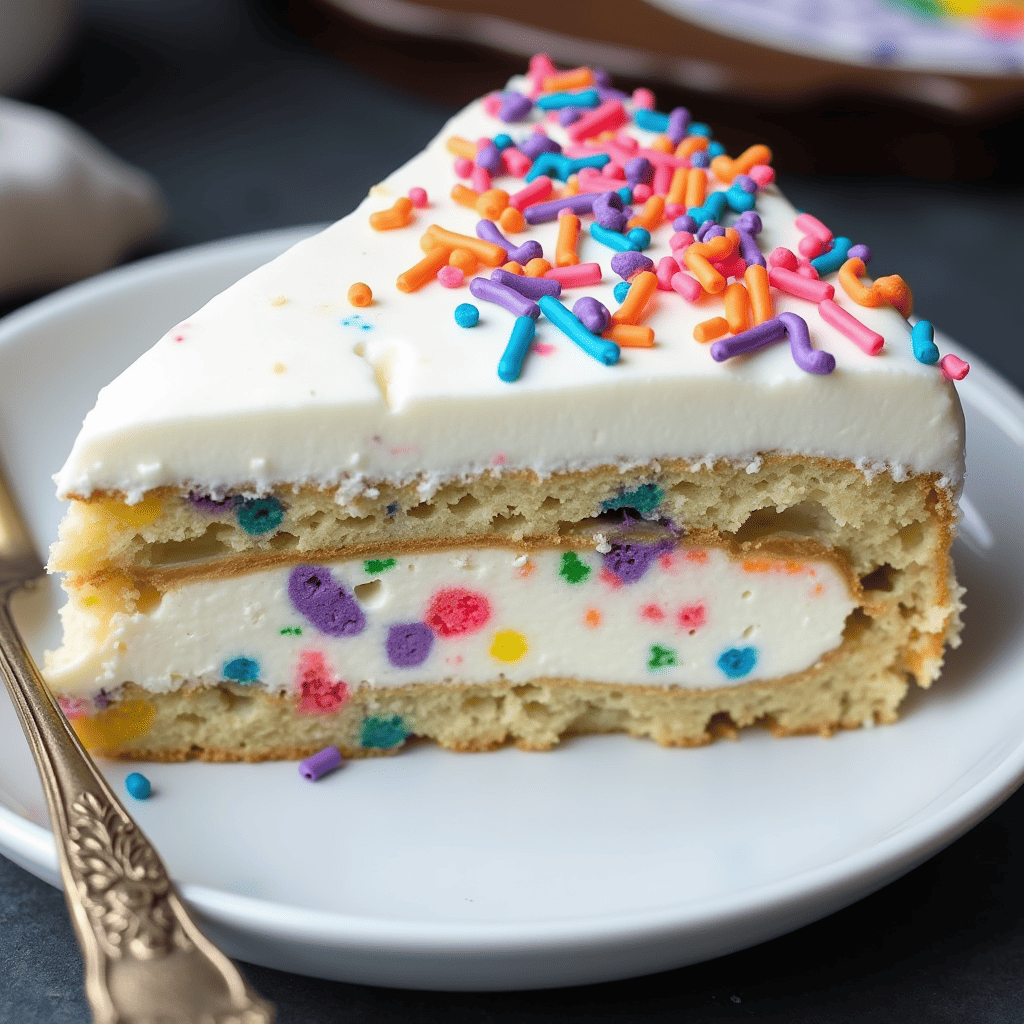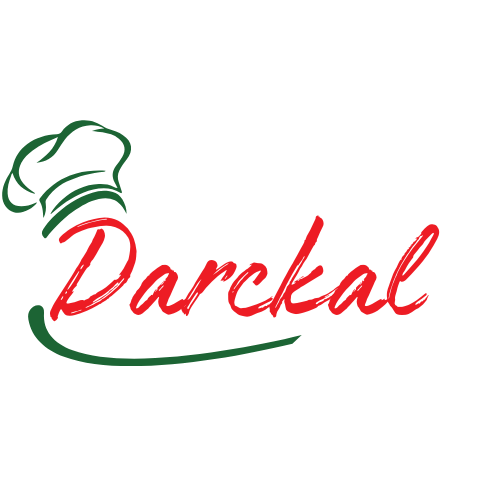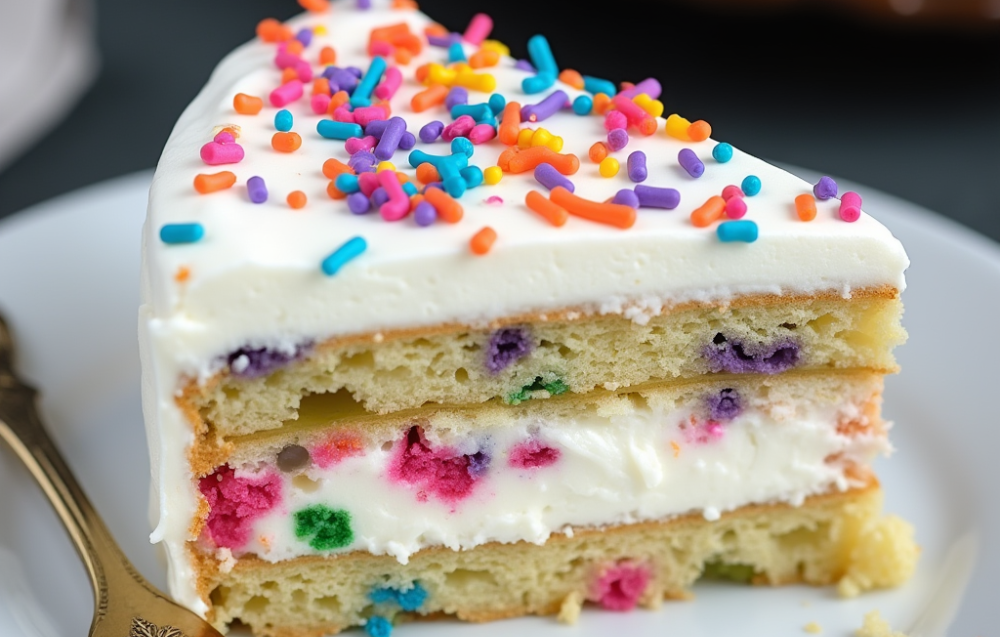Introduction to Vanilla Cake
Who doesn’t love a good vanilla cake? Whether it’s for birthdays, celebrations, or just a sweet craving on a lazy Sunday, vanilla cake is a timeless classic. It’s light, fluffy, and filled with that warm, comforting vanilla aroma that instantly makes any occasion special. But here’s the thing—while vanilla cake might seem simple, achieving that perfect texture and flavor requires the right ingredients, techniques, and a bit of baking wisdom.
Ever baked a vanilla cake that turned out too dry? Or maybe it sank in the middle? Don’t worry—you’re not alone. In this ultimate guide, I’ll walk you through everything you need to know about baking the perfect vanilla cake from scratch, along with solutions to the most common baking mishaps.
If you’re looking for more sweet treats, you might also love these Strawberry Cheesecake Cupcakes, which combine fruity flavors with a creamy texture!
So, grab your apron, and let’s dive into the world of vanilla cake!

Essential Ingredients for a Delicious Vanilla Cake
A great vanilla cake starts with high-quality ingredients. Each component plays a crucial role in creating that perfect balance of flavor, moisture, and texture. Let’s break them down:
The Role of Vanilla Extract in Flavor
The star of the show? Vanilla extract. It’s what gives vanilla cake its signature flavor. But not all vanilla extracts are created equal!
- Pure vanilla extract: Made from real vanilla beans, this is the best option for a deep, rich flavor.
- Imitation vanilla: Cheaper but lacks the complexity of real vanilla.
- Vanilla bean paste: A more concentrated form that includes actual vanilla bean specks—perfect for a gourmet touch!
🔹 Pro Tip: If you want a more intense vanilla taste, try using a mix of vanilla extract and vanilla bean paste!
For those who enjoy baking with alternative ingredients, you may want to check out this Perfect Gluten-Free Carrot Cake for a delicious gluten-free option.
Choosing the Right Flour, Sugar, and Butter
- Flour: All-purpose flour works, but for an extra tender crumb, go for cake flour. It has lower protein content, resulting in a softer texture.
- Sugar: Granulated sugar is standard, but for a finer texture, you can use caster sugar.
- Butter: Always use unsalted butter to control the amount of salt in your recipe. Room-temperature butter creams better, giving your cake that light, airy structure.
Eggs and Dairy: How They Affect Texture
Eggs provide structure and moisture. Large eggs are best because they help with the cake’s stability. Dairy, such as whole milk or buttermilk, enhances richness and keeps the cake moist.
🔹 Pro Tip: Using buttermilk instead of regular milk results in a softer, more tender cake!
Step-by-Step Guide: How to Make Vanilla Cake from Scratch
Alright, now that we know our ingredients, let’s get baking! Here’s a foolproof step-by-step guide to making a fluffy, moist vanilla cake.
Preparing the Ingredients and Equipment
Before you start, make sure you have:
✅ Two 8-inch round cake pans (or one 9×13-inch pan for a sheet cake)
✅ A hand mixer or stand mixer
✅ A sifter for dry ingredients
✅ Parchment paper for easy cake removal
🔹 Pro Tip: Always preheat your oven to 350°F (175°C) before you begin! A properly heated oven ensures even baking.
Mixing the Batter: Tips for a Smooth Consistency
Step 1: Cream the Butter and Sugar
- In a large bowl, beat 1 cup of unsalted butter with 1 ½ cups of sugar until light and fluffy (about 3-5 minutes).
- This process, called creaming, incorporates air, making your cake fluffy.
Step 2: Add the Eggs and Vanilla
- Add four eggs, one at a time, beating well after each addition.
- Mix in 2 teaspoons of pure vanilla extract.
Step 3: Combine Dry Ingredients
- In a separate bowl, whisk together:
- 2 ½ cups of cake flour
- 2 ½ teaspoons of baking powder
- ½ teaspoon of salt
Step 4: Alternate Adding Dry and Wet Ingredients
- Add half of the dry ingredients to the butter mixture, mixing on low speed.
- Pour in 1 cup of buttermilk and mix until just combined.
- Add the remaining dry ingredients and mix until smooth.
🔹 Pro Tip: Don’t overmix! Overmixing = dense cake. Mix just until everything is incorporated.
Baking the Cake: Temperature and Time Guidelines
Step 5: Prepare the Cake Pans
- Grease your cake pans and line them with parchment paper to prevent sticking.
Step 6: Pour and Bake
- Divide the batter evenly between the pans.
- Bake at 350°F (175°C) for 30-35 minutes, or until a toothpick inserted in the center comes out clean.
🔹 Pro Tip: If your cake domes in the center, don’t panic! Just trim the top with a serrated knife to level it before frosting.
For more creative baking ideas, check out this Cinnamon Toast Crunch Bread, a fun twist on a classic sweet treat!
Cooling and Frosting: How to Achieve the Best Results
Step 7: Let It Cool Properly
- Once baked, let the cakes cool in the pan for 10 minutes before transferring them to a wire rack.
- Wait until completely cool before frosting—otherwise, your frosting will melt!
🍰 “Patience is key in baking. A well-cooled cake holds its structure and absorbs frosting better!”
Step 8: Choose Your Frosting
- Classic vanilla buttercream: Smooth, sweet, and creamy—perfect for a traditional vanilla cake.
- Cream cheese frosting: Adds a tangy twist, great for balancing sweetness.
- Chocolate ganache: Because vanilla and chocolate are a match made in heaven!
Common Vanilla Cake Baking Mistakes and How to Fix Them
Even experienced bakers run into trouble sometimes. If your vanilla cake isn’t coming out as expected, don’t worry—here are the most common problems and how to fix them!
Why is My Vanilla Cake Dry? (Solutions)
A dry cake is a total disappointment, but it’s one of the most common baking issues. Here’s why it happens and how to prevent it:
❌ Overbaking – If your cake is in the oven too long, it’ll dry out.
✅ Fix: Set a timer and check for doneness a few minutes early. If the cake springs back when lightly pressed, it’s ready!
❌ Too much flour – Measuring flour incorrectly can make the cake too dense and dry.
✅ Fix: Always spoon and level your flour instead of scooping directly from the bag (which packs in too much flour). For a detailed guide on proper flour measurement, check out King Arthur Baking’s flour measurement tips.
❌ Not enough fat or liquid – Butter, eggs, and buttermilk keep the cake moist.
✅ Fix: Follow the recipe carefully. If you live in a dry climate, consider adding an extra tablespoon of milk to the batter.
How to Prevent a Dense or Heavy Cake?
Nobody wants a vanilla cake that feels like a brick. A dense cake usually happens due to:
❌ Overmixing the batter – This activates the gluten in the flour, making the cake tough.
✅ Fix: Mix just until the ingredients are combined—no more!
❌ Too little leavening agent – Baking powder helps the cake rise.
✅ Fix: Make sure your baking powder isn’t expired (yes, it has an expiration date!).
❌ Using cold ingredients – If your butter, eggs, or milk are cold, they won’t blend well.
✅ Fix: Bring all ingredients to room temperature before starting.
How to Stop Cakes from Sinking in the Middle?
Ever baked a cake that looked great in the oven but then collapsed once it cooled? It’s frustrating, but here’s what went wrong:
❌ Opening the oven door too soon – This lets cool air in, causing the cake to sink.
✅ Fix: Wait until at least ¾ of the baking time has passed before opening the oven.
❌ Too much leavening agent – Adding extra baking powder might seem like a good idea, but too much causes rapid rising and then sinking.
✅ Fix: Stick to the recipe measurements!
❌ Underbaking – A cake that’s not fully set in the middle will collapse.
✅ Fix: Insert a toothpick—if it comes out clean, the cake is ready.
🍰 “A cake is like a house—it needs a strong foundation (proper mixing), good insulation (correct baking temperature), and patience (cooling time)!”
Dealing with Uneven Baking or Browning Issues
If your cake is dark on one side but pale on the other, your oven might not be distributing heat evenly.
✅ Fix: Rotate your cake halfway through baking.
If your cake has a dark, thick crust, but the inside is raw:
✅ Fix: Lower the oven temperature by 25°F (about 10°C) and bake for a longer time.
Variations of Vanilla Cake Recipes
Want to switch things up? Here are some fun vanilla cake variations for different dietary needs and flavor twists!
Eggless Vanilla Cake Recipe
No eggs? No problem! Try this eggless vanilla cake:
✅ Substitute eggs with:
- ½ cup yogurt OR
- ½ cup unsweetened applesauce OR
- ¼ cup mashed bananas (for a hint of banana flavor!)
🔹 Pro Tip: Add 1 extra teaspoon of baking powder to help the cake rise without eggs.
For a classic vanilla cake recipe with step-by-step instructions, check out Sally’s Baking Addiction’s Vanilla Cake Recipe.
Gluten-Free Vanilla Cake
For a gluten-free vanilla cake, swap all-purpose flour for gluten-free 1:1 baking flour (like Bob’s Red Mill or King Arthur).
✅ Extra Tip: Add ½ teaspoon of xanthan gum to improve texture.
Vegan Vanilla Cake Options
To make a dairy-free and egg-free vanilla cake, use:
✅ Non-dairy milk (almond, oat, or soy)
✅ Coconut oil or vegan butter instead of regular butter
✅ Flax egg (1 tbsp ground flaxseed + 3 tbsp water = 1 egg)
🍰 “Who says vanilla cake can’t be for everyone? A few swaps, and boom—it’s eggless, gluten-free, or vegan!”
Best Frosting and Filling Ideas for Vanilla Cake
Frosting can take your vanilla cake from “just okay” to “WOW!”. Let’s explore some delicious options:
Classic Buttercream Frosting
The perfect sweet and creamy topping!
Ingredients:
- 1 cup unsalted butter (room temp)
- 3 ½ cups powdered sugar
- 2 tsp vanilla extract
- 3 tbsp heavy cream
Instructions:
- Beat the butter until creamy.
- Gradually add powdered sugar.
- Mix in vanilla and cream until fluffy.
Cream Cheese Frosting
If you love a tangy-sweet balance, this one’s for you!
Ingredients:
- 8 oz cream cheese (softened)
- ½ cup butter
- 3 cups powdered sugar
- 1 tsp vanilla
Instructions:
- Beat cream cheese and butter together.
- Add powdered sugar and vanilla.
- Mix until smooth.
🔹 Pairs well with fruit fillings like raspberry or lemon!
Chocolate Ganache and Other Toppings
For a rich twist, try a chocolate ganache drizzle or a caramel glaze.
✅ Ganache = melted chocolate + heavy cream (equal parts).
✅ Caramel glaze = sugar + butter + heavy cream (cooked until golden).
🍰 “Vanilla cake is like a blank canvas—paint it with buttercream, drizzle it with chocolate, or layer it with fruit!”
Storing and Preserving Your Vanilla Cake
Baked a cake but don’t want it to dry out? Here’s how to keep it fresh!
How to Keep Vanilla Cake Moist for Days
✅ Wrap it well – Use plastic wrap and store at room temperature for up to 3 days.
✅ Add simple syrup – Brushing your cake layers with sugar syrup keeps them extra moist.
Freezing and Reheating Tips
Want to freeze your cake for later? No problem!
✅ Freeze unfrosted layers – Wrap in plastic wrap + aluminum foil. Freeze for up to 3 months.
✅ Reheat gently – Let the cake thaw overnight in the fridge, then bring to room temperature.
🍰 “A well-stored cake tastes just as amazing a week later as it did on day one!”
Conclusion: Mastering the Art of Baking Vanilla Cake
Baking the perfect vanilla cake is all about balance—right ingredients, proper techniques, and a little patience. Whether you’re making a classic vanilla cake, trying an eggless or gluten-free version, or experimenting with fun frostings, you’ve got all the tools to succeed.
Now, it’s time to preheat that oven and start baking! 🚀🍰

